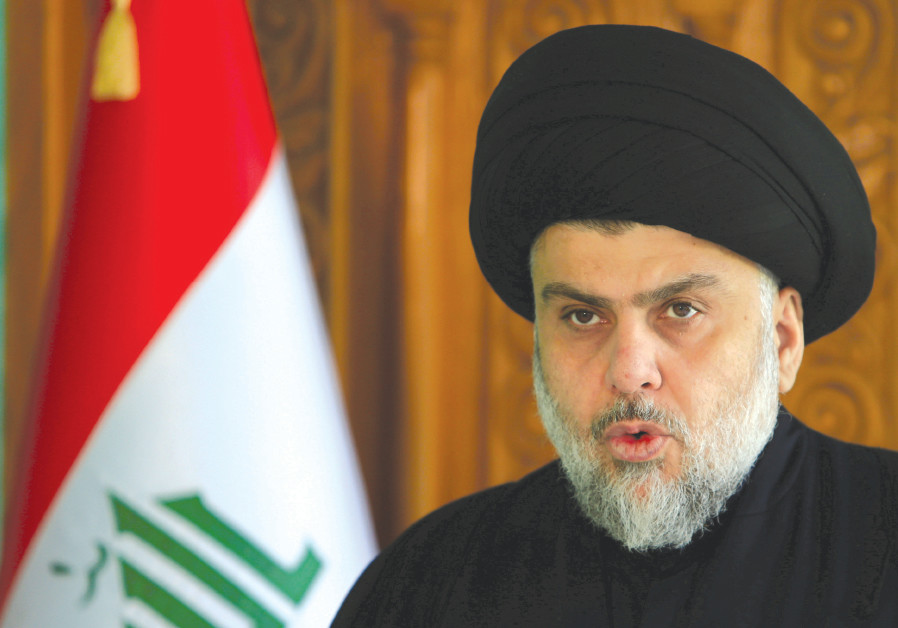How Iraq’s new PM could upend 15 years of U.S. Iraq policy

Muqtada al-Sadr. (photo credit: REUTERS)
Iraqi democracy has gone beyond anything Washington might have imagined when the US planned the invasion of Iraq in 2003.
Muqtada al-Sadr, whose militia once targeted US troops, came in first in the elections in mid-May. He now holds the key to power alongside another Shi’ite strongman and Iranian ally, Hadi al-Amiri. Whether Iraq gets Sadr’s brand of nationalism or Amiri’s brand of Tehran hegemony, Iraq has beguiled US policy-makers again.
In April 2004, Coalition Provisional Authority leader Paul Bremer gave a speech about the future of Iraq in which he said, “The enemies, domestic and foreign, of your bright future are trying to force you to take the path that leads backwards to brute force, division and hatred. These anti-democratic forces will not disappear by themselves, but working together we can defeat them.”
In June 2007, Bremer told CBS that Sadr was an “extremist” and “a very radical man.” He claimed Sadr was involved in the murder of a respected ayatollah named Adbul Majid Al-Khoei and that an arrest warrant had been issued for Sadr. However, Bremer says he was unable to persuade the US-led coalition to exercise the warrant.
Now Sadr is the kingmaker, and the Americans who ran Iraq in 2003 are mostly retired. Task And Purpose online magazine caught up with Bremer in March at Okemo Mountain Resort in Vermont, where he was dabbling in being a ski instructor. “Before he ran moguls, he ran Mosul,” the article quipped.
There have been no shortage of American plans for Iraq. The US thought Saddam Hussein would help blunt the Iranian Revolution’s extremism in the 1980s. And there is that famous video of Ronald Reagan’s envoy Donald Rumsfeld shaking hands with Saddam in 1983. Saddam invaded Kuwait and the US helped eject him, cobbling together a massive coalition to do so.
But the US abandoned the Shi’ites in the south, letting Saddam slaughter their rebels. In the north, Washington stuck by the Kurds, helping them carve out an area under air protection.
By 2003, Washington decided that removing Saddam completely was the right thing to do. Under the concepts of fighting weapons of mass destruction and bringing democracy to Iraq, the Ba’athist regime was swept aside and men like Bremer went to rebuild Iraq. What they got was an insurgency from Shi’ites like Sadr and from al-Qaeda. The insurgency would take five years to defeat, by which time the US decided it was time to leave Iraq.
But who to leave it to? In 2010, Nouri al-Maliki, a Shi’ite chauvinist strongman who was close to Tehran, placed second in Iraq’s elections.
Emma Sky, a political adviser to US Gen. Raymond Odierno, wrote on Politico.com in 2015 that the US abandoned democracy in Iraq, with the Obama administration deciding the country was not ready for democracy and needed a “Shia strongman.” So Maliki would take office, not the man who came in first, Ayad Allawi and his more secular party.
Odierno was dismayed that the US was stabilizing Iraq only to “hand it over to the Iranians in our rush to exit.” And that’s exactly what happened: The US exited; ISIS and extremism grew in the Sunni Arab provinces; the Kurds became alienated from Maliki’s thuggish politics; and by 2014, ISIS had easily captured a third of Iraq.
The US returned to Iraq in 2014 with the hope of setting things right once again. This time they found an ally in Prime Minister Haider al-Abadi, a little-known member of Maliki’s party who seemed amenable to the US. At the time, the Obama administration was working on the Iran deal, so Iran’s influence in Iraq was accepted by Washington.
By 2017, when Donald Trump came to power, Abadi was encouraged to patch things up with Saudi Arabia. Washington also opposed the Kurdish independence referendum, hoping that by doing so it would earn political capital with Abadi in Baghdad. Abadi appeared to be the new hope, but Washington didn’t expect that his “victory” coalition would perform so badly in the elections in May, coming in third.
For a country that has its own topsy-turvy democracy, the US has never come to grips with the nature of Iraqi democracy. US experts often express quiet disappointment over what they see in the Kurdish region as tribal or family politics. They seem surprised that voters do not choose what they see as new parties offering hope for change, like the Gorran Party, which claimed it would do away with family politics. They also seem oblivious to the nature of Iranian penetration into Kurdish politics, and that not everything is so simple.
They are often not keyed in to the realities on the ground in the rest of Iraq, not understanding that someone like Maliki might seem a good short-term choice but would harm Iraq in the long term. Now Sadr has performed well and Washington is left wondering what to do.
Secretary of State Mike Pompeo rolled out a robust policy of confronting Iran. But how does the US confront Iran in Iraq when pro-Iranian militias have been enshrined as an official part of government forces since 2016? How does the US confront Iran when IRGC Gen. Qassem Soleimani is in Iraq brokering coalition deals? And how does the US make amends for having dismayed friends in the Kurdish region and elsewhere by seeming to break past promises?
One of the ironies of democratization is this: If you support democracy, you also have to accept what it produces, which may not be the allies you expected.





Comments are closed.